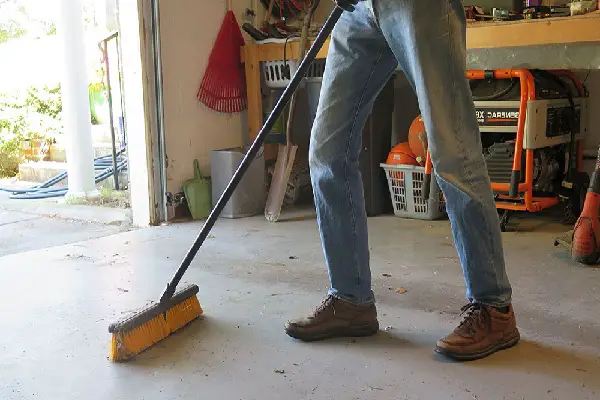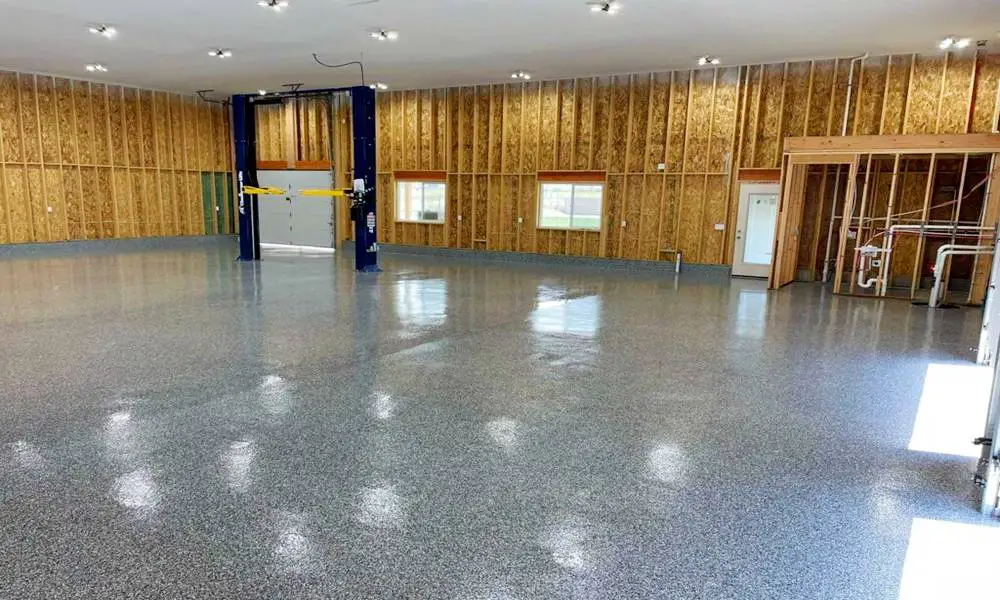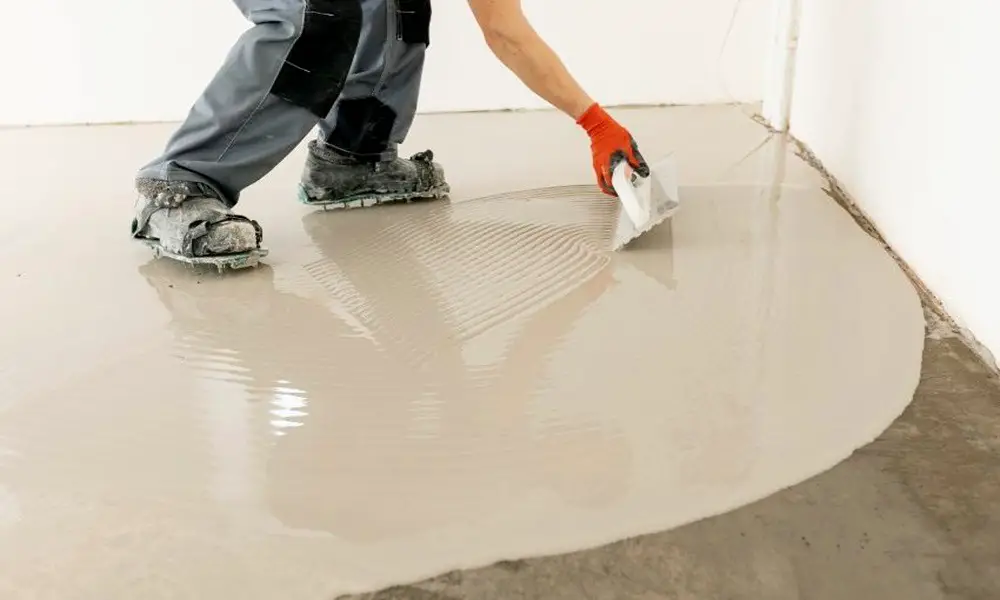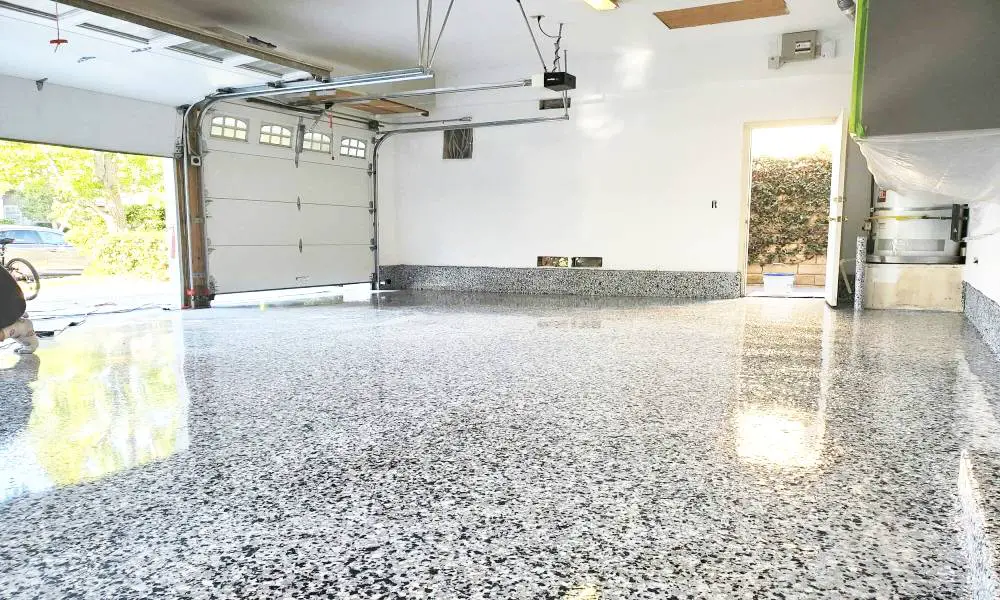How to Clean Garage Floor Without Pressure Washer
How to wash concrete garage floor Concrete garage floors are often dirty and stained. Oil, gasoline, and other dirt can […]

How to wash concrete garage floor

Concrete garage floors are often dirty and stained. Oil, gasoline, and other dirt can stick to the concrete surface, making it look dull and unattractive. Luckily, cleaning a concrete garage floor is not as difficult as you might think.
By following the proper steps and using appropriate cleaning products, you can return your garage floor to a clean, sparkling condition.
Why Clean Your Garage Floor Regularly
Regularly cleaning your garage floor is vital for maintaining its cleanliness and improving its longevity. By removing dirt, grime, and stains, you can prevent potential damage to the concrete and create a more pleasant and inviting space in your garage. While you have the option to hire professional garage floor cleaning services, this guide will focus on providing you with DIY cleaning methods that you can easily implement.
The Importance of Maintaining Garage Floor Cleanliness
Maintaining garage floor cleanliness goes beyond just visual appeal. Here are a few reasons why regular cleaning is essential:
- Prevent Damage: Dirt, oil spills, and other debris can gradually wear down the surface of your garage floor, leading to cracks and structural issues.
- Enhance Safety: A clean garage floor reduces the risk of slips, trips, and falls, ensuring a safer environment for both you and your vehicles.
- Remove Stains and Odors: Cleaning your garage floor regularly helps eliminate stubborn stains, unpleasant odors, and the accumulation of bacteria or mold.
- Preserve Your Investment: By maintaining the cleanliness of your garage floor, you can increase its lifespan and protect the value of your property.
While professional garage floor cleaning services may provide a convenient solution, opting for DIY cleaning methods allows you to save money and have more control over the process.
| Maintaining Garage Floor Cleanliness | Professional Garage Floor Cleaning Services | |
|---|---|---|
| Cost | Cost-effective, as you can use household cleaning products | May incur additional expenses, especially for larger garage spaces |
| Flexibility | You can schedule cleaning based on your convenience and preferences | Professional services offer flexible scheduling options |
| Control | You have control over the cleaning process and the products used | Trained professionals perform the cleaning, ensuring high-quality results |
| Expertise | Allows you to gain firsthand knowledge and experience in maintaining your garage floor | Professional cleaners have the expertise and specialized equipment for thorough cleaning |
Whether you choose to clean your garage floor yourself or hire professional services, the ultimate goal is to maintain a clean and well-cared-for garage floor that enhances the overall functionality and aesthetics of your garage space. In the following sections, I will guide you through various DIY cleaning methods and techniques to help you achieve just that.
Assessing the Condition of Your Garage Floor
Before embarking on the DIY garage floor cleaning process, it’s crucial to assess the condition of your garage floor. By thoroughly examining the surface, you can identify any stains, cracks, or other issues that may require additional attention or repairs. Here are some key steps to assess the condition of your garage floor:
Gather Your Equipment
Before getting started, gather the following items:
- Broom or brush
- Dustpan
- Flashlight
- Gloves
- Eye protection
- Inspecting tools (such as a magnifying glass, if needed)
Step-by-Step Assessment
- Clear the Floor: Remove any objects, tools, or debris from the garage floor. This will allow you to thoroughly examine the surface.
- Inspect for Stains: Carefully examine the floor for any stains. Pay attention to areas that might be prone to oil spills, grease marks, or chemical stains. Take note of the type and severity of each stain.
- Check for Cracks: Inspect the garage floor for cracks or uneven areas. Use a flashlight and inspecting tools if necessary to identify any hidden cracks that may require repair.
- Look for Damage: Check for any signs of damage, such as chipped or broken concrete. These areas might require specialized attention or repair before cleaning.
Recording Your Findings
To keep track of your assessment, create a simple table to record the findings:
| Condition | Description |
|---|---|
| Stains | Oil spills, grease marks, chemical stains |
| Cracks | Size, location, severity |
| Damage | Chipped or broken concrete |
By assessing the condition of your garage floor, you can develop a targeted cleaning plan that addresses specific issues. This allows you to choose the most suitable DIY cleaning methods and products to achieve a flawless and revitalized garage floor.
Gathering the Necessary Equipment and Supplies
When it comes to effectively washing your concrete garage floor, having the right equipment and supplies is crucial. Let me guide you through the process of compiling a list of essential items that will help you achieve a spotless and inviting garage space.
Brooms and Brushes
Start by ensuring you have a sturdy broom and brushes specifically designed for cleaning garage floors. These tools will help you remove loose dirt, debris, and dust from the surface before applying any cleaning solutions.
Cleaning Solutions
Choose high-quality cleaning solutions that are specifically formulated for garage floors. Look for products that are tough on grease, stains, and grime, while still being safe for the concrete. You can find these solutions at your local hardware or home improvement store.
Protective Gear
Wearing the right protective gear is essential when cleaning your garage floor to safeguard your health. Make sure you have the following items:
- Protective gloves to shield your hands from cleaning chemicals
- Safety goggles to protect your eyes from any splashes or debris
- A respiratory mask or a dust mask to avoid inhaling dust particles or fumes
Pressure Washer or Power Washer
If you prefer a quicker and more efficient cleaning method, consider investing in a pressure washer or power washer. These machines use high-pressure water to remove stubborn stains and dirt. However, it’s important to follow the manufacturer’s instructions and use the appropriate nozzle and pressure settings to avoid damaging the concrete.
Additional Supplies
Here are some additional supplies that can be helpful in the garage floor cleaning process:
- Scrub brushes with stiff bristles for scrubbing stubborn stains
- A wet-dry vacuum cleaner for handling excess water
- A mop or a squeegee for drying the floor after cleaning
- A bucket or a sprayer for mixing and applying cleaning solutions
- Microfiber cloths or towels for drying and wiping surfaces
By gathering these necessary equipment and supplies, you’ll be well-equipped to tackle the task of cleaning your concrete garage floor. In the next section, I’ll guide you through the process of preparing your garage for cleaning.
Preparing Your Garage for Cleaning
Before you begin the process of cleaning garage floor, it’s important to properly prepare the space. Taking the time to remove items, clear debris, and address any stubborn stains or oil spills will ensure optimal results and a thorough cleaning. Here are the essential steps to prepare your garage for cleaning:
1. Remove Items
Start by removing any items or vehicles from your garage. This will provide you with a clean and empty space to work with, making it easier to access all areas of the floor and clean them effectively.
2. Clear Debris
Sweep or use a leaf blower to clear away any loose dirt, leaves, or debris from the garage floor. This will prevent these particles from getting in the way during the cleaning process or being pushed into the floor’s surface.
3. Address Stubborn Stains or Oil Spills
If you notice any stubborn stains or oil spills on your garage floor, it’s important to address them before starting the cleaning process. Use an appropriate stain remover or oil absorbent to treat these areas and let them sit for the recommended amount of time before proceeding with the cleaning.
Tip: For DIY stain remover, create a paste using baking soda and water. Apply it to the stain and let it sit for a few hours. Scrub the area with a brush before rinsing it off.
By following these steps to prepare your garage for cleaning, you’ll set a solid foundation for a successful cleaning process. Ensuring a clean and clear space will maximize the effectiveness of your chosen cleaning method and help you achieve the best possible results.
| Items to Remove | Tools and Equipment Needed |
|---|---|
| 1. Vehicles | 1. Broom or leaf blower |
| 2. Tools and equipment | 2. Stain remover or oil absorbent |
| 3. Stored items | 3. Brush for scrubbing stains |
Choosing the Right Cleaning Method
When it comes to washing your concrete garage floor, there are several cleaning methods you can choose from. Let’s explore each method and discuss their pros and cons, so you can determine the best approach for your needs.
1. Traditional Scrubbing
If you prefer a hands-on approach, traditional scrubbing is an effective way to clean your garage floor. This method involves using a scrub brush or broom along with a cleaning solution to manually scrub away dirt, grime, and stains. It can be time-consuming, especially for larger garage floors, but it allows for targeted cleaning and greater control over the pressure exerted on the surface.
2. Pressure Washing
Power washing, also known as pressure washing, is a popular choice for cleaning garage floors. This method utilizes a high-pressure water spray to blast away dirt, debris, and stains. Power washing can be quick and efficient, making it particularly suitable for large garage floors or heavily soiled surfaces. However, it’s important to note that excessive water pressure or incorrect technique can damage the concrete, so it’s essential to follow proper guidelines and maintain a safe distance from the surface.
3. Specialty Cleaning Solutions
In addition to traditional scrubbing and power washing, you can also consider specialty cleaning solutions for specific stains or issues on your garage floor. These solutions are formulated to target stubborn oil stains, rust marks, or other types of hard-to-remove stains. They often require additional steps, such as pre-treating the area or using specific tools, but they can provide effective results for challenging cleaning tasks.
Remember, it’s crucial to consider the condition of your garage floor, the severity of stains, and your personal preferences when choosing a cleaning method. Take the time to evaluate each option and assess which one aligns best with your needs and resources.
| Cleaning Method | Pros | Cons |
|---|---|---|
| Traditional Scrubbing | – Allows for targeted cleaning – Greater control over pressure – Suitable for smaller areas |
– Time-consuming for large floors |
| Pressure Washing | – Quick and efficient – Great for large garage floors – Effective on stubborn stains |
– Risk of concrete damage if used incorrectly |
| Specialty Cleaning Solutions | – Targets specific stains – Effective results for challenging cleaning tasks |
– Additional steps and tools may be required |
Consider the advantages and disadvantages of each cleaning method and choose the one that suits your preferences, time constraints, and the condition of your garage floor. Don’t hesitate to seek professional advice or services if you’re unsure or need assistance with the cleaning process.
Scrubbing and Stain Removal Techniques
When it comes to cleaning your concrete garage floor, scrubbing and stain removal techniques are essential for achieving a pristine finish. Whether you’re dealing with oil stains, grease, or other stubborn marks, I’ve got you covered with effective strategies and concrete garage floor cleaning tips.
1. Preparing the Surface
Before tackling any stains, it’s important to start with a clean surface. Sweep or use a leaf blower to remove loose debris and dirt. Once the surface is clear, use a mild detergent mixed with warm water to mop the area. This initial cleaning will help loosen any dirt or grime, making it easier to tackle specific stains.
2. Tackling Oil Stains
Oil stains can be a common nuisance in garage floors. To remove them, start by blotting up any excess oil with absorbent materials, such as cat litter or sawdust. Next, create a paste using baking soda and water, and apply it directly to the stain. Allow it to sit for a few hours or overnight, giving it time to draw out the oil. Finally, scrub the area with a stiff-bristle brush and rinse with water.
3. Dealing with Grease and Other Stains
If you’re faced with stubborn grease stains or other marks, a mixture of warm water and dish soap can be highly effective. Apply the soapy mixture to the stain and scrub gently with a brush. For tougher stains, you may need to let the soapy solution sit for a few minutes before scrubbing. Rinse the area thoroughly with water to remove the soap residue.
4. Removing Rust Stains
Rust stains can be particularly challenging to remove from concrete floors. One effective method is to use a solution of lemon juice and salt. Sprinkle the salt directly onto the rust stain, ensuring it is fully covered. Squeeze lemon juice over the salt and let it sit for several hours or overnight. Scrub the area with a brush and rinse thoroughly. Repeat the process if necessary.
5. Preventative Measures
To maintain a clean garage floor and prevent future stains, consider applying a concrete sealer or epoxy coating. These protective layers can help repel spills and make cleaning easier in the long run. Additionally, using mats or absorbent pads under vehicles can catch drips and prevent oil stains from seeping into the concrete.
By following these concrete garage floor cleaning tips and using effective scrubbing and stain removal techniques, you can restore the beauty of your garage floor and create a clean and inviting space.
| Stain Type | Removal Method |
|---|---|
| Oil Stains | Blot excess oil, apply baking soda paste, scrub with a brush, rinse with water |
| Grease and Other Stains | Mix warm water and dish soap, scrub gently, rinse with water |
| Rust Stains | Sprinkle salt, squeeze lemon juice, let it sit, scrub with a brush, rinse thoroughly |
Power Washing Your Garage Floor
When it comes to cleaning large garage floors, power washing can be an incredibly efficient method. By harnessing the force of pressurized water, you can remove tough stains and dirt with ease. However, it’s important to follow a few essential guidelines to ensure optimal results and protect your concrete floor.
Dos and Don’ts of Power Washing
To power wash your garage floor effectively, keep the following tips in mind:
- DO adjust the water pressure: Set your power washer to a suitable pressure level for concrete surfaces. Higher pressure may remove stains more effectively, but be cautious not to damage the concrete.
- DO maintain a proper distance: Stand about 12-18 inches away from the floor while power washing. This distance helps prevent any accidental damage that could occur if the nozzle is held too close to the surface.
- DO wear protective gear: Prioritize your safety by wearing appropriate protective gear, such as goggles and rubber boots. This will shield you from flying debris and keep you safe from potential slip hazards.
- DON’T use excessive pressure: While power washing can be powerful, avoid using excessive pressure that may cause pitting or erosion on the concrete surface. Start with lower pressure settings and increase gradually if needed.
- DON’T overlook the edges: Pay attention to the corners and edges of your garage floor. These areas can accumulate dirt and grime, so be sure to thoroughly clean them during the power washing process.
“Power washing can be a quick and effective way to clean your garage floor. Just remember to use the right pressure, maintain a suitable distance, and protect yourself with proper gear.”
By following these dos and don’ts of power washing, you can confidently tackle the cleaning process and achieve a fresh and vibrant garage floor.
| Pros | Cons |
|---|---|
| Efficiently removes stubborn stains | Potential risk of damage if used incorrectly |
| Requires less physical effort compared to manual scrubbing | May not be suitable for delicate surfaces or loose concrete |
| Time-saving for large garage floors | Can create water runoff that needs proper drainage |
Despite its effectiveness, power washing may not be suitable for all garage floors. Delicate surfaces or loose concrete may be better cleaned using alternative methods.
Now that you understand the dos and don’ts of power washing your garage floor, it’s time to delve into the process of applying protective coatings and sealants, ensuring a long-lasting and polished finish.
Applying Protective Coatings and Sealants
Once your garage floor is clean, it’s important to take the necessary steps to protect it from future stains and damage. Applying protective coatings and sealants can significantly enhance the longevity and appearance of your floor, ensuring that it remains clean and well-maintained for years to come.
There are various types of protective coatings and sealants available in the market, each offering unique benefits and features. Whether you choose a penetrating sealer, epoxy coating, or polyurethane coating, it’s essential to select a product that suits your specific needs and preferences.
Benefits of applying protective coatings and sealants:
- Maintaining garage floor cleanliness: Protective coatings and sealants create a barrier on the surface of your garage floor, preventing dirt, oil, and other substances from penetrating and staining the concrete. This makes it much easier to clean and maintain your garage floor on a regular basis.
- Enhancing durability: The application of a protective coating or sealant adds an extra layer of strength and resilience to your garage floor. It helps to prevent cracks, chips, and other forms of damage caused by heavy foot traffic, vehicle movement, or accidental impacts.
- Improving appearance: The right protective coating or sealant can enhance the overall aesthetics of your garage floor. It can provide a glossy or satin finish, transforming the dull and worn-out appearance of your concrete into a visually appealing and inviting space.
- Protecting against chemicals and spills: Certain coatings and sealants offer excellent resistance against chemicals, oil, gasoline, and other substances commonly found in garages. This ensures that accidental spills or leaks don’t cause long-term damage or discoloration to your garage floor.
While some DIY enthusiasts may choose to apply protective coatings and sealants themselves, it’s worth considering professional garage floor cleaning services for a flawless and long-lasting finish. Professional cleaners have the expertise, experience, and equipment necessary to ensure proper application and optimal results.
By applying protective coatings and sealants to your clean garage floor, you can safeguard its cleanliness and maintain its pristine appearance. Whether you tackle the task yourself or enlist the help of professionals, investing in these measures will undoubtedly prolong the life of your garage floor and contribute to a cleaner and more enjoyable space.
Regular Maintenance Tips for a Clean Garage Floor
Maintaining a clean garage floor is essential for preserving its appearance and functionality. By following these practical tips for ongoing maintenance, you can ensure that your garage floor remains spotless, safe, and inviting.
1. Sweep Regularly
One of the simplest and most effective ways to maintain a clean garage floor is by sweeping it regularly. Use a broom or a dust mop to remove dust, dirt, and debris from the surface. This will prevent these particles from accumulating and causing stains.
2. Mop as Needed
In addition to sweeping, you should also mop your garage floor as needed. Fill a bucket with warm water and a mild soap or a concrete floor cleaner. Dip a mop into the solution and wring it out well. Then, thoroughly mop the entire floor, paying attention to any areas with stains or spills. Rinse the mop frequently to avoid spreading dirt or grime.
3. Address Spills and Stains Promptly
Spills and stains are inevitable in a garage. To maintain a clean floor, it’s crucial to address them promptly. Wipe up any spills immediately to prevent them from seeping into the concrete and causing permanent stains. For stubborn stains, you can use a specific stain remover or create a paste from baking soda and water, which acts as a natural cleaner and can help lift the stain.
4. Use Floor Mats or Rugs
Protect your garage floor from dirt, oil, and other substances by using floor mats or rugs in high-traffic areas. These protective coverings can effectively prevent stains and make cleaning easier.
5. Prevent Oil and Chemical Stains
If you regularly work with oil or chemicals in your garage, take preventive measures to avoid stains. Place a drip tray or absorbent material underneath vehicles or equipment to catch any drips. Promptly clean up any spills using an oil absorbent product or cat litter to prevent them from penetrating the concrete.
6. Avoid Abrasive Cleaners
When cleaning your garage floor, avoid using abrasive cleaners or tools that can damage the surface. Harsh chemicals, bleach, or wire brushes can cause etching or scratches. Stick to mild soaps, concrete floor cleaners, and soft-bristle brushes for gentle yet effective cleaning.
7. Conduct Regular Inspections
Periodically inspect your garage floor for any signs of damage or wear. Look for cracks, chips, or areas where the concrete is deteriorating. Address these issues promptly to prevent further damage and maintain the cleanliness of your garage floor.
By following these regular maintenance tips, you can ensure that your garage floor remains clean, presentable, and in excellent condition for years to come.
Conclusion
By following the tips and techniques outlined in this guide, you can master the art of washing your concrete garage floor. Whether you choose to take on the task yourself or hire professional services, achieving a spotless and inviting space is within your reach.
A clean garage floor not only enhances the overall functionality and appeal of your garage, but it also extends the lifespan of the concrete. Regular maintenance and cleaning prevent stains, damage, and deterioration, ensuring that your garage remains a clean and well-maintained space for years to come.
Remember to assess the condition of your garage floor, gather the necessary equipment and supplies, and prepare your garage before cleaning. Choose the cleaning method that suits your needs, whether it’s traditional scrubbing, power washing, or specialty cleaning solutions. Don’t forget to apply protective coatings and sealants to protect your floor from future stains and damage.
Enjoy the satisfaction of a pristine garage floor, knowing that you have taken the necessary steps to maintain its cleanliness and longevity. Embrace the transformation and utilize these expert tips to keep your garage floor looking its best.









